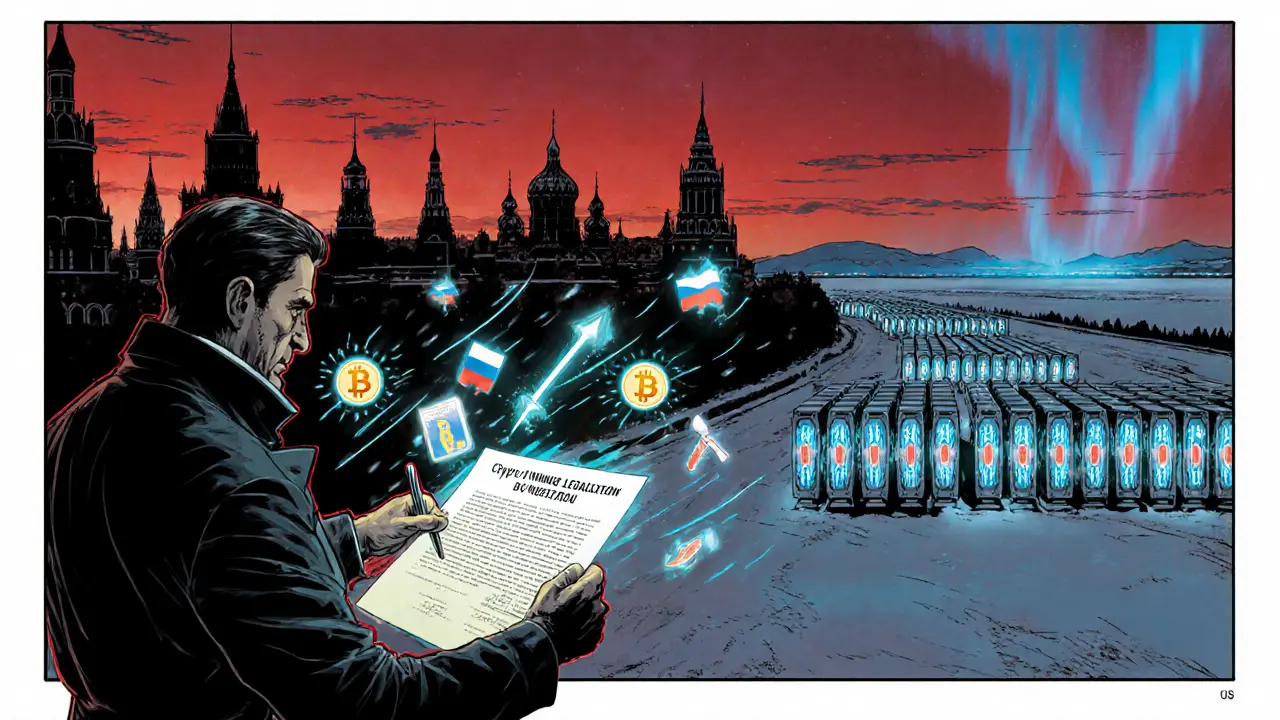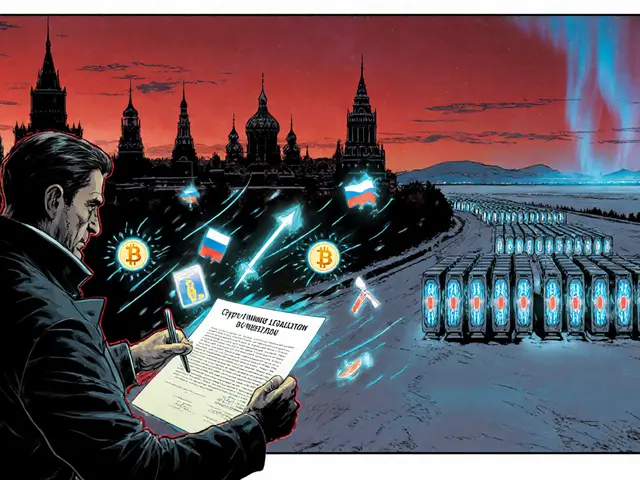- Home
- Cryptocurrency
- Russia Legalizes Crypto Mining to Bypass Sanctions - What It Means

Russia Legalizes Crypto Mining to Bypass Sanctions - What It Means
Russian Crypto Sanctions Risk Calculator
Evaluate the sanctions risk level of potential crypto transactions involving Russian entities based on transaction characteristics.
Risk Assessment Results
When Russia a trans‑Eurasian federation facing Western financial restrictions since 2022 announced a new policy that crypto mining legalization would be part of its economic strategy, the world’s eyes turned to a shadowy crypto ecosystem that has been quietly reshaping how the country moves money around the globe.
Background: From Restrictive Oversight to Strategic Adoption
Initially, Moscow treated digital assets with caution, applying a patchwork of licensing requirements and bans on anonymous wallets. That approach shifted after the February2022 invasion of Ukraine, when the United States, the European Union, and the United Kingdom slapped sweeping sanctions on banks, energy firms, and key oligarchs.
To keep its economy afloat, Russian policymakers began to see cryptocurrency not as a speculative fad but as a potential sanctions evasion tool a financial mechanism designed to operate outside Western‑controlled payment rails. The shift accelerated in 2023‑2024 as state‑linked tech firms started piloting stablecoins and mining farms in remote Siberian regions where electricity is cheap.
What the New Law Actually Allows
In early2025, the Russian Ministry of Finance issued a decree that lifted previous bans on large‑scale mining operations and explicitly permitted cross‑border crypto payments for “strategic economic purposes.” The decree defines three core freedoms:
- Legal operation of mining facilities with annual output above 50petahashes without the need for special licenses.
- Use of domestically issued stablecoins for settlement of imports, especially for goods excluded from the sanction list.
- Direct access for Russian banks to crypto‑exchange APIs, provided they register their AML/KYC procedures with the Central Bank.
The law also mandates that all mining profits be taxed at a flat 13% rate and that a portion of the energy consumed be sourced from renewable projects, a move framed as “energy independence.”
The A7A5 Stablecoin Network - A Case Study
At the heart of the new ecosystem lies the A7A5 stablecoin a ruble‑backed cryptocurrency launched in February2025 by Old Vector, a Kyrgyzstan‑based firm backed by Promsvyazbank. Within its first four months, A7A5 facilitated roughly $9.3billion in transactions, primarily between Russian exporters and overseas buyers using the token as a bridge to evade dollar‑based sanctions.
Key features of A7A5 include:
- Full ruble collateral held in a network of Kyrgyz banks, providing a veneer of official backing.
- Integration with Garantex a crypto exchange with deep Russian ties, sanctioned by the US in 2022 for primary trading.
- A sister platform, Grinex a 2024‑launched exchange created by former Garantex staff specifically to dodge sanctions, sanctioned again in August2025.
By July2025, the token had processed over $51billion in total volume, making it one of the most active sanction‑circumvention tools on the blockchain.

Western Counter‑Measures: Sanctions on the Crypto Front
The United States responded on August202025 by designating the first virtual‑currency mining company under OFAC’s authority. U.S. Treasury the Office of Foreign Assets Control (OFAC), responsible for enforcing economic and trade sanctions cited the mining sector’s role in funding Russia’s “brutal war of choice.” The UK’s Office of Financial Sanctions Implementation the UK body that enforces sanctions and anti‑money‑laundering regulations simultaneously targeted Grinex, Old Vector, and several Kyrgyz entities.
Sanctions now cover not just the crypto‑exchange platforms but also the supporting infrastructure: payment processors, energy providers, and even the individuals who run the mining farms. According to a recent Treasury list, more than 40 persons and entities linked to the A7A5 network have been designated.
Effectiveness and Limits of Crypto‑Based Evasion
While the numbers sound impressive, analysts warn that crypto cannot replace the dollar or euro for Russia’s $400billion annual export volume. The Bitcoin Policy Institute a research organization focused on the economic impact of Bitcoin argues that Bitcoin’s market cap-roughly half of Russia’s pre‑war export value-makes it “far too small and volatile” to serve as a primary trade currency.
Chainalysis, a blockchain‑analytics firm, describes the Russian crypto ecosystem as a “shadow crypto economy” that provides liquidity and a degree of anonymity, yet it also leaves a digital trail that authorities can follow. The firm notes that the same transparency that enables evasion also aids detection, leading to arrests and asset freezes.
In practice, the crypto route appears most useful for high‑value, low‑frequency transactions, such as procurement of military equipment, rather than bulk commodity shipments.
Geopolitical Implications and Future Outlook
Legalizing mining sends a signal: Russia is willing to invest in alternative financial infrastructure to reduce dependence on Western systems. The move may inspire other sanctioned states-North Korea, Venezuela-to double down on crypto strategies, potentially spawning a new sub‑genre of state‑backed digital assets.
However, the rapid sanctioning response from the US, UK, and EU suggests that the crypto‑evasion playbook will face escalating legal and technical barriers. As blockchain forensics improve and international cooperation deepens, Russia’s ability to use crypto at scale could be dramatically curtailed.
For businesses eyeing the Russian market, the key takeaway is caution. Any partnership that involves A7A5, Grinex, or newly licensed mining firms should be vetted against the latest OFAC and OFSI lists.

Practical Checklist for Navigating the New Landscape
- Verify whether a crypto service is on the OFAC or OFSI sanctions list before onboarding.
- Conduct enhanced AML/KYC checks on all counterparties dealing with stablecoins tied to ruble collateral.
- Monitor blockchain analytics platforms (e.g., Chainalysis) for red‑flag transactions involving A7A5 or related wallets.
- Consider alternative settlement methods, such as non‑USD fiat corridors, if crypto risk is deemed too high.
- Stay updated on Russian regulatory notices, especially any changes to mining tax rates or licensing requirements.
Comparison of Key Crypto Instruments in Russian Sanctions Evasion
| Attribute | A7A5 Stablecoin | Bitcoin | Euro |
|---|---|---|---|
| Backing | Ruble collateral in Kyrgyz banks | Decentralized, no backing | European Central Bank reserves |
| Volume (2025 Q3) | $51billion | $1.2trillion (global) | $1.4trillion (global) |
| Volatility (30‑day) | ≈2% | ≈5% | ≈0.7% |
| Sanction status | Targeted by US/UK (2025) | Not directly sanctioned but used for evasion | Subject to traditional financial sanctions |
| Typical use case | Large‑scale trade, military procurement | Speculative investment, limited trade | Standard international trade |
Frequently Asked Questions
Why did Russia decide to legalize crypto mining?
The move aims to create a domestic source of digital currency that can fund the economy and bypass sanctions that block traditional banking channels.
What is the A7A5 stablecoin and how does it work?
A7A5 is a ruble‑backed token issued by Old Vector. Each token is backed by rubles held in Kyrgyz banks, allowing users to move value on the blockchain without involving the dollar‑based SWIFT system.
Are the newly licensed mining farms subject to international sanctions?
Several mining operators have already been added to OFAC and OFSI lists, especially those linked to state agencies or sanctioned financial institutions.
Can western companies safely do business with Russian entities using crypto?
Risk is high. Companies must perform thorough sanctions screening and may need to obtain export licenses before engaging in any crypto‑based transactions with Russian parties.
Will crypto mining become a major part of Russia’s energy consumption?
The government encourages mining in regions with abundant cheap power, but environmental concerns and possible future caps on electricity use could limit rapid expansion.
Cormac Riverton
I'm a blockchain analyst and private investor specializing in cryptocurrencies and equity markets. I research tokenomics, on-chain data, and market microstructure, and advise startups on exchange listings. I also write practical explainers and strategy notes for retail traders and fund teams. My work blends quantitative analysis with clear storytelling to make complex systems understandable.
Popular Articles
7 Comments
Write a comment Cancel reply
About
DEX Maniac is your hub for blockchain knowledge, cryptocurrencies, and global markets. Explore guides on crypto coins, DeFi, and decentralized exchanges with clear, actionable insights. Compare crypto exchanges, track airdrop opportunities, and follow timely market analysis across crypto and stocks. Stay informed with curated news, tools, and insights for smarter decisions.





The imperialist narrative obscures the genuine ingenuity of Russian crypto policy.
One could argue that the state’s embrace of mining is a pragmatic response to economic isolation. Yet philosophy teaches us to question the ethical underpinnings of such a choice. Is profit being placed above collective responsibility? The answer remains elusive.
In accordance with prevailing international statutes, the recent legislative adjustment by the Russian Federation raises substantial concerns. The legal text appears to contravene the spirit of the sanctions regime. Moreover, the lack of transparent oversight mechanisms exacerbates the risk of illicit activity. Accordingly, stakeholders should exercise heightened vigilance.
From an analytical perspective, the decision to legalize crypto mining is not merely a loophole but a strategic maneuver. It aligns with the nation’s historical propensity for leveraging technology to offset external pressures. The friendly tone of the announcement masks the underlying competitive edge sought by the state. Still, the data suggests a potential surge in hash power originating from Russian farms.
Let’s break this down step by step, because the implications are far more complicated than a simple headline suggests. First, the Russian government’s move to legalize crypto mining is a direct response to the sanctions that have crippled traditional energy markets. By providing a legal framework, they are essentially creating a safe harbor for miners to operate without the fear of immediate crackdowns. Second, this policy is likely to attract both domestic and foreign investment into the mining sector, as investors search for jurisdictions with less regulatory friction.
Third, the environmental impact cannot be ignored; Russia’s vast energy resources, particularly natural gas, make it uniquely positioned to power large-scale operations at a lower cost, potentially outcompeting Western miners who face higher electricity prices and stricter carbon regulations. Fourth, there’s a geopolitical angle: a surge in Russian-controlled hash power could shift the balance of power in several blockchain networks, giving the state indirect influence over decentralized systems.
Fifth, the sanctions risk calculus changes dramatically. While the U.S. and EU have targeted Russian financial institutions, mining revenues can be funneled through crypto channels that are harder to monitor, effectively bypassing traditional financial surveillance. Sixth, this move may prompt other sanctioned or semi-sanctioned nations to follow suit, creating a new enclave of crypto-friendly jurisdictions.
Seventh, stakeholders in the global crypto market need to reassess risk models, incorporating the possibility of increased Russian mining capacity into their analyses. Eighth, compliance teams will have to develop more sophisticated tools to trace transaction flows that may originate from or pass through Russian entities.
Finally, the broader takeaway is that this policy underscores the adaptability of crypto ecosystems in the face of geopolitical pressure. Whether this translates into a net positive or negative for the global economy depends on how quickly regulators can adapt and how responsibly the mining operations manage their environmental and financial footprints.
In response to the prior analysis, one must contemplate the moral dimension of technology serving as a shield against collective sanctions. The philosophical discourse invites us to scrutinize whether such adaptation is an act of resilience or an evasion of communal responsibility. The tension between sovereignty and global order persists.
Patriotic investors should rejoice; this move cements Russia’s position as a crypto powerhouse and counters Western economic warfare. The law is clear, the opportunity is massive, and anyone not taking advantage is simply naive. Let the markets speak.